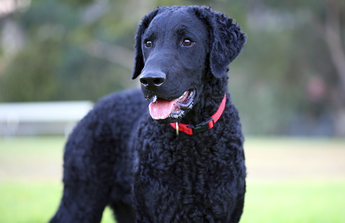This Irish redhead has a coat that’s moderately long on the body and short and fine on the head and front legs, with long, silky feathering on the ears, the backs of the legs, the chest, the belly, and the tail.
The coat needs brushing and combing two or three times a week to prevent or remove mats and tangles. A bath every two to four weeks or so doesn’t go amiss. Tips on grooming and the best tools to use are available fromthis Irish Setter breeder.
The rest is basic care. Trim the nails as needed, usually every week or two. Brush the teeth frequently with a vet-approved pet toothpaste for good overall health and fresh breath. Keep the long, hanging ears clean and dry to help prevent bacterial or yeast infections from developing.
Irish Setters can have a high tolerance for exercise so it’s important that they get outdoors and revel in their instincts on a habitual basis.
With plenty of lean weight, Irish Setters will be agile and capable of plenty of running, so don’t go easy on them all the time. Get an Irish Setter feeling like a part of a team and it will feel like it’s in its natural environment.
The Irish Setter should be fed a high-qualitydog foodappropriate for the dog’s age (puppy, adult, or senior) and activity level.Learn about whichhuman foodsare safe for dogs, and which are not.
The breed can experiencebloat, sudden and life-threatening swelling of the abdomen, and owners should educate themselves about its symptoms and what to do should bloat occur. The causes of bloat aren’t fully understood, but experts agree that multiple, small meals and preventing vigorous exercise around mealtimes may help reduce the risk of bloating.
The average life expectancy for the Irish Setter is 11 to 14 years. Breed health concerns may include arthritis,bloat (gastric dilatation and volvulus), canine leukocyte adhesion deficiency,entropion,corneal ulceration, epilepsy,hip dysplasia, hypertrophic osteodystrophy,hypothyroidism, insulinoma, Irish Setter hypochondroplasia, congenital idiopathic megaesophagus,melanoma, vascular ring anomaly, osteosarcoma,patent ductus arteriosus,progressive retinal atrophyandvon Willebrand disease.
The Irish Setter is happy, affectionate, and eager to please. He is full of energy and will appreciate having a job to do. Keep training methods consistent but sessions fun and interesting to be sure he does not become bored. He responds best to positive, reward-based training methods, and not well to heavy-handed or harsh corrections.
Earlysocializationandpuppy training classesare recommended. Irish Setters excel in canine sports such as hunting, agility, dock diving, rally, tracking, and flyball, and their sensitive nature makes them natural as therapy and assistance dogs.











